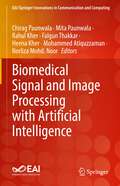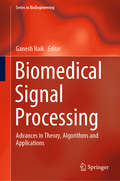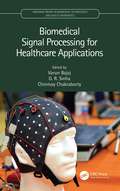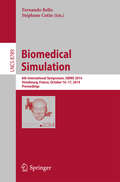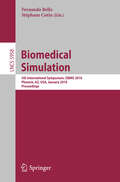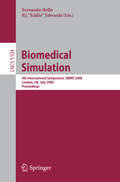- Table View
- List View
The Biomedical Sciences in Society: An Interdisciplinary Analysis
by Iain CrinsonThis textbook provides a comprehensive introduction to the interdisciplinary field of the Social Studies of Science and Technology (SSST). Over the past two decades, the biomedical sciences have transformed our understanding of the relationship between the social and natural worlds, while its ‘promissory visions’ are seen to offer extraordinary opportunities for economic and social development. But alongside these scientific innovations have emerged new, and frequently unanticipated social, political, bioethical, and legal dilemmas and challenges. This cutting-edge text explores ‘post-genomic’ developments in the field of pharmacogenomics and the prospects for a new ‘precision’ or personalised medicine; the potential of environmental epigenetics to reconfigure the boundaries of the social and natural worlds; the emergence of an array of ‘neuro-disciplines’, seeking to identify the neural basis of a whole range of social and economic behaviours; and the challenges of constructing a coherent and robust governance framework for the conduct of biomedical science research and innovation, responsive to the social and health needs of the whole population.
Biomedical Sensing and Analysis: Signal Processing in Medicine and Biology
by Iyad Obeid Joseph Picone Ivan SelesnickThis book provides an interdisciplinary look at emerging trends in signal processing and biomedicine found at the intersection of healthcare, engineering, and computer science. Bringing together expanded versions of selected papers presented at the 2020 IEEE Signal Processing in Medicine and Biology Symposium (IEEE SPMB), it examines the vital role signal processing plays in enabling a new generation of technology based on big data and looks at applications ranging from medical electronics to data mining of electronic medical records. Topics covered include analysis of medical images, machine learning, biomedical nanosensors, wireless technologies, and instrumentation and electrical stimulation. Biomedical Sensing and Analysis: Signal Processing in Medicine and Biology presents tutorials and examples of successful applications, and will appeal to a wide range of professionals, researchers, and students interested in applications of signal processing, medicine, and biology.Presents an interdisciplinary look at research trends in signal processing and biomedicine;Promotes collaboration between healthcare practitioners and signal processing researchers;Includes tutorials and examples of successful applications.
Biomedical Sensors and Instruments
by Tatsuo Tagawa Toshiyo Tamura P. Ake ObergThe living body is a difficult object to measure: accurate measurements of physiological signals require sensors and instruments capable of high specificity and selectivity that do not interfere with the systems under study. As a result, detailed knowledge of sensor and instrument properties is required to be able to select the "best" sensor from o
Biomedical Sensors and Measurement (Advanced Topics in Science and Technology in China)
by Ping Wang Qingjun Liu"Biomedical Sensors and Measurement" is an interdisciplinary book combining electronics with biology and medicine. It gives an overview of the concept and principle of biomedical sensors and measurement. First, the basic theory and technology are explained, followed by details of the physical sensors, chemical sensors, biosensors and their typical applications in biomedicine. Furthermore, the interface technology of the sensors and the typical measurement systems is presented. The large amount of vivid and specific figures and formulas will help to deepen the understanding of the fundamental and new applications involving biomedical sensors and measurement technology. The book is intended for biomedical engineers, medical physicists and other researchers and professionals in biomedicine-related specialties, especially interdisciplinary studies. Prof. Ping Wang and Dr. Qingjun Liu both work at the Biosensor National Special Laboratory, Key Laboratory for Biomedical Engineering of Education Ministry, Department of Biomedical Engineering, Zhejiang University, China.
Biomedical Signal and Image Processing
by Kayvan NajarianAll of the biomedical measurement technologies, which are now instrumental to the medical field, are essentially useless without proper signal and image processing. Biomedical Signal and Image Processing is unique in providing a comprehensive survey of all the conventional and advanced imaging modalities and the main computational methods used for
Biomedical Signal and Image Processing
by Robert Splinter Kayvan NajarianFirst published in 2005, Biomedical Signal and Image Processing received wide and welcome reception from universities and industry research institutions alike, offering detailed, yet accessible information at the reference, upper undergraduate, and first year graduate level. Retaining all of the quality and precision of the first edition, Biomedica
Biomedical Signal and Image Processing
by Robert Splinter Kayvan NajarianWritten for senior-level and first year graduate students in biomedical signal and image processing, this book describes fundamental signal and image processing techniques that are used to process biomedical information. The book also discusses application of these techniques in the processing of some of the main biomedical signals and images, such as EEG, ECG, MRI, and CT. New features of this edition include the technical updating of each chapter along with the addition of many more examples, the majority of which are MATLAB based.
Biomedical Signal and Image Processing with Artificial Intelligence (EAI/Springer Innovations in Communication and Computing)
by Chirag Paunwala Mita Paunwala Rahul Kher Falgun Thakkar Heena Kher Mohammed Atiquzzaman Norliza Mohd. NoorThis book focuses on advanced techniques used for feature extraction, analysis, recognition, and classification in the area of biomedical signal and image processing. Contributions cover all aspects of artificial intelligence, machine learning, and deep learning in the field of biomedical signal and image processing using novel and unexplored techniques and methodologies. The book covers recent developments in both medical images and signals analyzed by artificial intelligence techniques. The authors also cover topics related to development based artificial intelligence, which includes machine learning, neural networks, and deep learning. This book will provide a platform for researchers who are working in the area of artificial intelligence for biomedical applications.Provides insights into medical signal and image analysis using artificial intelligence;Includes novel and recent trends of decision support system for medical research;Outlines employment of evolutionary algorithms for biomedical data, big data analysis for medical databases, and reliability, opportunities, and challenges in clinical data.
Biomedical Signal Processing: Advances in Theory, Algorithms and Applications (Series in BioEngineering)
by Ganesh NaikThis book reports on the latest advances in the study of biomedical signal processing, and discusses in detail a number of open problems concerning clinical, biomedical and neural signals. It methodically collects and presents in a unified form the research findings previously scattered throughout various scientific journals and conference proceedings. In addition, the chapters are self-contained and can be read independently. Accordingly, the book will be of interest to university researchers, R&D engineers and graduate students who wish to learn the core principles of biomedical signal analysis, algorithms, and applications, while also offering a valuable reference work for biomedical engineers and clinicians who wish to learn more about the theory and recent applications of neural engineering and biomedical signal processing.
Biomedical Signal Processing: A Modern Approach (Biomedical Signal and Image Processing)
by Ganesh R. Naik Wellington Pinheiro Dos SantosThis book presents the theoretical basis and applications of biomedical signal analysis and processing. Initially, the nature of the most common biomedical signals, such as electroencephalography, electromyography, electrocardiography and others, is described. The theoretical basis of linear signal processing is summarized, with continuous and discrete representation, linear filters and convolutions, Fourier and Wavelets transforms. Machine learning concepts are also presented, from classic methods to deep neural networks. Finally, several applications in neuroscience are presented and discussed, involving diagnosis and therapy, in addition to other applications. Features: Explains signal processing of neuroscience applications using modern data science techniques. Provides comprehensible review on biomedical signals nature and acquisition aspects. Focusses on selected applications of neurosciences, cardiovascular and muscle-related biomedical areas. Includes computational intelligence, machine learning and biomedical signal processing and analysis. Reviews theoretical basis of deep learning and state-of-the-art biomedical signal processing and analysis. This book is aimed at researchers, graduate students in biomedical signal processing, signal processing, electrical engineering, neuroscience and computer science.
Biomedical Signal Processing: A Modern Approach (Biomedical Signal and Image Processing)
by Ganesh R. Naik Wellington Pinheiro dos SantosThis book presents the theoretical basis and applications of biomedical signal analysis and processing. Initially, the nature of the most common biomedical signals, such as electroencephalography, electromyography, electrocardiography and others, is described. The theoretical basis of linear signal processing is summarized, with continuous and discrete representation, linear filters and convolutions, Fourier and Wavelets transforms. Machine learning concepts are also presented, from classic methods to deep neural networks. Finally, several applications in neuroscience are presented and discussed, involving diagnosis and therapy, in addition to other applications. Features: Explains signal processing of neuroscience applications using modern data science techniques. Provides comprehensible review on biomedical signals nature and acquisition aspects. Focusses on selected applications of neurosciences, cardiovascular and muscle-related biomedical areas. Includes computational intelligence, machine learning and biomedical signal processing and analysis. Reviews theoretical basis of deep learning and state-of-the-art biomedical signal processing and analysis. This book is aimed at researchers, graduate students in biomedical signal processing, signal processing, electrical engineering, neuroscience and computer science.
Biomedical Signal Processing: Innovation and Applications
by Iyad Obeid Ivan Selesnick Joseph PiconeThis book provides an interdisciplinary look at emerging trends in signal processing and biomedicine found at the intersection of healthcare, engineering, and computer science. It examines the vital role signal processing plays in enabling a new generation of technology based on big data, and looks at applications ranging from medical electronics to data mining of electronic medical records. Topics covered include analysis of medical images, machine learning, biomedical nanosensors, wireless technologies, and instrumentation and electrical stimulation. Biomedical Signal Processing: Innovation and Applications presents tutorials and examples of successful applications, and will appeal to a wide range of professionals, researchers, and students interested in applications of signal processing, medicine, and biology.
Biomedical Signal Processing for Healthcare Applications (Emerging Trends in Biomedical Technologies and Health informatics)
by Varun Bajaj G. R. Sinha Chinmay ChakrabortyThis book examines the use of biomedical signal processing—EEG, EMG, and ECG—in analyzing and diagnosing various medical conditions, particularly diseases related to the heart and brain. In combination with machine learning tools and other optimization methods, the analysis of biomedical signals greatly benefits the healthcare sector by improving patient outcomes through early, reliable detection. The discussion of these modalities promotes better understanding, analysis, and application of biomedical signal processing for specific diseases. The major highlights of Biomedical Signal Processing for Healthcare Applications include biomedical signals, acquisition of signals, pre-processing and analysis, post-processing and classification of the signals, and application of analysis and classification for the diagnosis of brain- and heart-related diseases. Emphasis is given to brain and heart signals because incomplete interpretations are made by physicians of these aspects in several situations, and these partial interpretations lead to major complications. FEATURES Examines modeling and acquisition of biomedical signals of different disorders Discusses CAD-based analysis of diagnosis useful for healthcare Includes all important modalities of biomedical signals, such as EEG, EMG, MEG, ECG, and PCG Includes case studies and research directions, including novel approaches used in advanced healthcare systems This book can be used by a wide range of users, including students, research scholars, faculty, and practitioners in the field of biomedical engineering and medical image analysis and diagnosis.
Biomedical Signal Processing for Healthcare Applications (Emerging Trends in Biomedical Technologies and Health informatics)
by Varun Bajaj G. R. Sinha Chinmay ChakrabortyThis book examines the use of biomedical signal processing—EEG, EMG, and ECG—in analyzing and diagnosing various medical conditions, particularly diseases related to the heart and brain. In combination with machine learning tools and other optimization methods, the analysis of biomedical signals greatly benefits the healthcare sector by improving patient outcomes through early, reliable detection. The discussion of these modalities promotes better understanding, analysis, and application of biomedical signal processing for specific diseases. The major highlights of Biomedical Signal Processing for Healthcare Applications include biomedical signals, acquisition of signals, pre-processing and analysis, post-processing and classification of the signals, and application of analysis and classification for the diagnosis of brain- and heart-related diseases. Emphasis is given to brain and heart signals because incomplete interpretations are made by physicians of these aspects in several situations, and these partial interpretations lead to major complications. FEATURES Examines modeling and acquisition of biomedical signals of different disorders Discusses CAD-based analysis of diagnosis useful for healthcare Includes all important modalities of biomedical signals, such as EEG, EMG, MEG, ECG, and PCG Includes case studies and research directions, including novel approaches used in advanced healthcare systems This book can be used by a wide range of users, including students, research scholars, faculty, and practitioners in the field of biomedical engineering and medical image analysis and diagnosis.
Biomedical Signals and Sensors I: Linking Physiological Phenomena and Biosignals (Biological and Medical Physics, Biomedical Engineering)
by Eugenijus KaniusasThis two-volume set focuses on the interface between physiologic mechanisms and diagnostic human engineering. Today numerous biomedical sensors are commonplace in clinical practice. The registered biosignals reflect mostly vital physiologic phenomena. In order to adequately apply biomedical sensors and reasonably interpret the corresponding biosignals, a proper understanding of the involved physiologic phenomena, their influence on the registered biosignals, and the technology behind the sensors is necessary. The first volume is devoted to the interface between physiologic mechanisms and arising biosignals, whereas the second volume is focussed on the interface between biosignals and biomedical sensors. The physiologic mechanisms behind the biosignals are described from the basic cellular level up to their advanced mutual coordination level during sleep. The arising biosignals are discussed within the scope of vital physiologic phenomena to foster their understanding and comprehensive analysis.
Biomedical Signals and Sensors II: Linking Acoustic and Optic Biosignals and Biomedical Sensors (Biological and Medical Physics, Biomedical Engineering)
by Eugenijus KaniusasThe book set develops a bridge between physiologic mechanisms and diagnostic human engineering. While the first volume is focused on the interface between physiologic mechanisms and the resultant biosignals, this second volume is devoted to the interface between biosignals and biomedical sensors. That is, in the first volume, the physiologic mechanisms determining biosignals are described from the basic cellular level up to their advanced mutual coordination level. This second volume, considers the genesis of acoustic and optic biosignals and the associated sensing technology from a strategic point of view. As a novelty, this book discusses heterogeneous biosignals within a common frame. This frame comprises both the biosignal formation path from the biosignal source at the physiological level to biosignal propagation in the body, and the biosignal sensing path from the biosignal transmission in the sensor applied on the body up to its conversion to a, usually electric, signal.Some biosignals arise in the course of the body’s vital functions while others map these functions that convey physiological data to an observer. It is highly instructive how sound and light beams interact with biological tissues, yielding acoustic and optic biosignals, respectively. Discussed phenomena teach a lot about the physics of sound and physics of light (as engineering sciences), and, on the other hand, biology and physiology (as live sciences). The highly interdisciplinary nature of biosignals and biomedical sensors is obviously a challenge. However, it is a rewarding challenge after it has been coped with in a strategic way, as offered here. The book is intended to have the presence to answer intriguing “Aha!” questions.
Biomedical Signals and Sensors III: Linking Electric Biosignals and Biomedical Sensors (Biological and Medical Physics, Biomedical Engineering)
by Eugenijus KaniusasAs the third volume in the author’s series on “Biomedical Signals and Sensors,” this book explains in a highly instructive way how electric, magnetic and electromagnetic fields propagate and interact with biological tissues. The series provides a bridge between physiological mechanisms and theranostic human engineering. The first volume focuses on the interface between physiological mechanisms and the resultant biosignals that are commonplace in clinical practice. The physiologic mechanisms determining biosignals are described from the cellular level up to the mutual coordination at the organ level. In turn, the second volume considers the genesis of acoustic and optic biosignals and the associated sensing technology from a strategic point of view. This third volume addresses the interface between electric biosignals and biomedical sensors. Electric biosignals are considered, starting with the biosignal formation path to biosignal propagation in the body and finally to the biosignal sensing path and the recording of the signal. The series also emphasizes the common features of acoustic, optic and electric biosignals, which are ostensibly entirely different in terms of their physical nature. Readers will learn how these electric, magnetic and electromagnetic fields propagate and interact with biological tissues, are influenced by inhomogeneity effects, cause neuromuscular stimulation and thermal effects, and finally pass the electrode/tissue boundary to be recorded. As such, the book helps them manage the challenges posed by the highly interdisciplinary nature of biosignals and biomedical sensors by presenting the basics of electrical engineering, physics, biology and physiology that are needed to understand the relevant phenomena.
Biomedical Signals and Systems (Synthesis Lectures on Biomedical Engineering)
by Joseph TranquilloBiomedical Signals and Systems is meant to accompany a one-semester undergraduate signals and systems course. It may also serve as a quick-start for graduate students or faculty interested in how signals and systems techniques can be applied to living systems. The biological nature of the examples allows for systems thinking to be applied to electrical, mechanical, fluid, chemical, thermal and even optical systems. Each chapter focuses on a topic from classic signals and systems theory: System block diagrams, mathematical models, transforms, stability, feedback, system response, control, time and frequency analysis and filters. Embedded within each chapter are examples from the biological world, ranging from medical devices to cell and molecular biology. While the focus of the book is on the theory of analog signals and systems, many chapters also introduce the corresponding topics in the digital realm. Although some derivations appear, the focus is on the concepts and how to apply them. Throughout the text, systems vocabulary is introduced which will allow the reader to read more advanced literature and communicate with scientist and engineers. Homework and Matlab simulation exercises are presented at the end of each chapter and challenge readers to not only perform calculations and simulations but also to recognize the real-world signals and systems around them. Table of Contents: Preface / Acknowledgments / Introduction / System Types / System Models / Laplace Transform / Block Diagrams / Stability / Feedback / System Response / Control / Time Domain Analysis / Frequency Domain Analysis / Filters / Author's Biography
Biomedical Signals Based Computer-Aided Diagnosis for Neurological Disorders
by M. Murugappan Rajamanickam YuvarajBiomedical signals provide unprecedented insight into abnormal or anomalous neurological conditions. The computer-aided diagnosis (CAD) system plays a key role in detecting neurological abnormalities and improving diagnosis and treatment consistency in medicine. This book covers different aspects of biomedical signals-based systems used in the automatic detection/identification of neurological disorders. Several biomedical signals are introduced and analyzed, including electroencephalogram (EEG), electrocardiogram (ECG), heart rate (HR), magnetoencephalogram (MEG), and electromyogram (EMG). It explains the role of the CAD system in processing biomedical signals and the application to neurological disorder diagnosis. The book provides the basics of biomedical signal processing, optimization methods, and machine learning/deep learning techniques used in designing CAD systems for neurological disorders.
Biomedical Signals, Imaging, and Informatics
by Joseph D. Bronzino Donald R. PetersonKnown as the bible of biomedical engineering, The Biomedical Engineering Handbook, Fourth Edition, sets the standard against which all other references of this nature are measured. As such, it has served as a major resource for both skilled professionals and novices to biomedical engineering.Biomedical Signals, Imaging, and Informatics, the third v
Biomedical Simulation: 6th International Symposium, ISBMS 2014, Strasbourg, France, October 16-17, 2014, Proceedings (Lecture Notes in Computer Science #8789)
by Fernando Bello Stephane CotinThis book constitutes the thoroughly refereed conference proceedings of the 6th International Symposium on Biomedical Simulation (ISBMS) which was held in Strasbourg, France, in October 2014. Biomedical modeling and simulation are at the center stage of worldwide efforts to understand and replicate the behavior and function of the human organism. Large scale initiatives such as the Physiome Project, Virtual Physiological Human and Blue Brain Project aim to develop advanced computational models that will facilitate the understanding of the integrative function of cells, organs, and organisms, with the ultimate goal of delivering truly personalized medicine. At the same time, progress in modeling, numerical techniques and haptics has enabled more complex and interactive simulations. The 27 revised full papers (including 16 regular and 11 short papers) were carefully selected from 45 submissions and cover topics such as training systems and haptics, physics-based registration, vascular modeling and simulation, image and simulation, modeling, surgical planning, analysis, characterization and validation.
Biomedical Simulation: 5th International Symposium, ISBMS 2010, Phoenix, AZ, USA, January 23-24, 2010. Proceedings (Lecture Notes in Computer Science #5958)
by Fernando Bello Stéphane CotinBiomedical Simulation: 4th International Symposium, ISBMS 2008, London, UK, July 7-8, 2008, Proceedings (Lecture Notes in Computer Science #5104)
by Fernando Bello Eddie EdwardsThis book constitutes the refereed proceedings of the 4th International Symposium on Biomedical Simulation, ISBMS 2008, held in London, UK, in July 2008. The 19 revised full papers and 7 poster papers presented were carefully reviewed and selected from numerous submissions. The papers are organized in four different sections corresponding to key areas and techniques of this constantly expanding field: finite element modeling, mass spring and statistical shape modeling, motion and fluid modeling and implementation issues. An additional section covers the posters presented at the meeting.
Biomedical Simulation: Third International Symposium, ISBMS 2006, Zurich, Switzerland, July 10-11, 2006, Proceedings (Lecture Notes in Computer Science #4072)
by Matthias Harders Gábor SzékelyThis book constitutes the refereed proceedings of the Third International Symposium on Biomedical Simulation, ISBMS 2006, held in Zurich, Switzerland in July 2006. The 12 revised full papers and 11 poster papers presented were carefully reviewed and selected from 37 submissions. The papers are organized in topical sections on simulation of biophysical processes, systems and applications, and anatomical modeling and tissue properties.
Biomedical Statistics: A Beginner's Guide
by Shakti Kumar Yadav Sompal Singh Ruchika GuptaThis book is written in a very easy-to-follow format, and explains the key concepts of biomedical statistics in a lucid yet straightforward manner. It explains how mathematical and statistical tools can be used to find answers to common research questions. In addition, the main text is supplemented by a wealth of solved exercises and illustrative examples to aid in comprehension. Given its content, the book offers an invaluable quick reference guide for graduating students and can be very helpful in their examination process. At the same time, it represents a handy guide for medical and paramedical teachers, post-graduate medical students, research personnel, biomedical scientists and epidemiologists.






